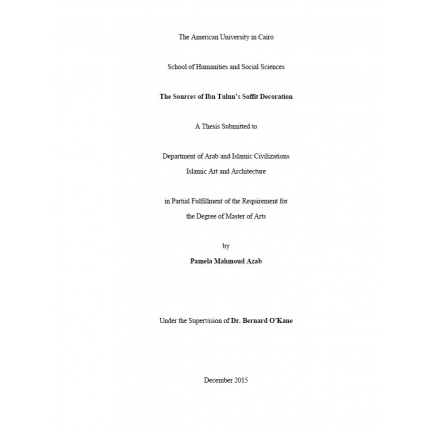
The sources of Ibn Tulun's soffit decoration
Date Added
21/07/2022
Content Type
Dissertation
Category
Masters
Link to Content
Subject Area
Mosques
Author
Pamela Mahmoud Azab
Publisher Name
American University in Cairo
Year of Publication
2016
Description
The mosque of Ahmad ibn Tulun is one of the most important
mosques in Egypt. It is the second largest mosque in Cairo, the third congregational
mosque; it was built in 876 by Ahmad ibn Tulun. The most striking feature of the
mosque is its stucco decoration. There is no evidence of the presence of this style of
stucco, which was strongly influenced from Samarra, in any other monuments in
Egypt; the mosque of Ibn Tulun is the only monument standing today in Cairo which
has this style of stucco apart from the remains of a small Tulunid hammam that was
discovered in 1932 and was decorated with stucco.1 The stucco designs on the soffits
while being strongly influenced by Samarra, arguably display also Roman and
Byzantine influences. The soffits are carved with intricate abstract floral designs very
similar to Samarra stucco, but in a geometric framework that shows Roman and
Byzantine influence as well. Both geometric and vegetal patterns are found which
when combined lead to countless varieties of ornamental patterns are of late antique
times.2 Samarra styles A and B (explained in chapter two) represent an evolutionary
process that underwent a development from Sasanian stucco until it was employed at
Ibn Tulun; for example the vine scroll transformed gradually from a naturalistic
pattern into an abstract pattern.3 The analysis of Roman and Byzantine mosaics will
indicate a connection to the patterns used in Ibn Tulun. This has been noticed by
earlier scholars. According to Ernst Diez, the geometric patterns of Ibn Tulun mosque
show the influence of Roman mosaics from late antique times as well as that of
Sasanian stucco.4 According to Doris Behrens-Abouseif, the decoration of Ibn
Tulun’s mosque shows a strong influence of Byzantine and Samarran works of art.5
She also mentions that Sasanian culture inspired the works of the Abbasids and that
both the Byzantine and Sasanian cultures contributed to the evolution of the
naturalistic floral and abstract decorative patterns.6 Some of the motifs like the
herringbone border, pearls and spiral are Byzantine and were used later by
Mesopotamian and Coptic artists.7 The geometric patterns can be generated by using
some fundamentals of mathematics. For example by using circles and connecting the
centers with straight lines a triangular grid with a symmetrical pattern can be
achieved, and by connecting the centers in a triangular grid, a rhombic or a hexagonal
grid can be achieved.8
Files
English
Arab & Islamic Civilizations Department
Pamela Mahmoud Azab
American University in Cairo
2015





